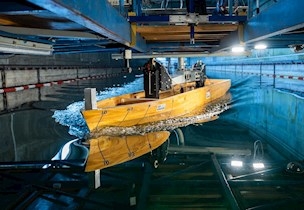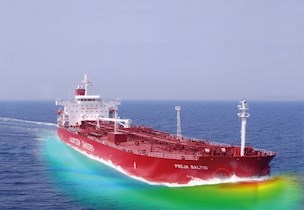Manoeuvring evaluation
Critical situations at sea require good manoeuvring qualities, it is therefore of paramount importance that every vessel has optimum manoeuvring capabilities.
Besides the general requirements outlined by IMO, there are normally requirements to the vessel related to the specific operation of the vessel. In order to evaluate the manoeuvring characteristics, model tests can be performed at the early design stage.
Manoeuvring tests in the tank
Normally the manoeuvring tests are carried out as captive tests in our towing tank in our state of the art Large Amplitude Planar Motion Mechanism (LAPMM). These tests enable a fast and accurate determination of the manoeuvring characteristics of the vessel utilising the still water model.
Moreover, such tests provide the necessary input for the numerical model description used in the simulator. Alternatively, the manoeuvring tests can be carried out as free sailing tests where the vessel is controlled by an autopilot or with a man in the loop. These tests are either carried out in our own facility (small manoeuvres) or at the facilities of our colleagues around the world.
Evaluation of maneuverability in the early design phase
In order to help our clients evaluate the manoeuvring characteristics of ships in the early design phase, FORCE Technology has developed a prediction tool named SimFlex ShipYard.SimFlex ShipYard
SimFlex ShipYard is a cost-effective empirical manoeuvring prediction tool based on a neural network over of FORCE Technology’s extensive database with PMM test results. It is typically used for evaluation of standard manoeuvres like 10/10 and 20/20 zig-zag, turning circle with 35 degrees of rudder and crash stop, and the results are delivered in both graphical and tabular form including a comparison with the IMO criteria.
ShipYard has been used for many types of ships ranging from small vessels up to VLCCs and very large container vessels and for different propulsion and rudder systems. The idea behind the method is to estimate the manoeuvring characteristics based on PMM data from existing ships similar to the one considered in the new design project. In this process, it is important to identify the characteristic parameters for the considered type of ship and use these in the search for parent ships matching the new design.
The prediction tool is fast to run, and it can basically be run in two modes:
- A simple prediction of the manoeuvring characteristics based on the main particulars of the ship
- An advanced prediction where a sophisticated set of characteristic parameters are used to describe the hull shape. This involves import of a 3D hull definition.




